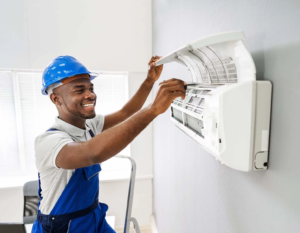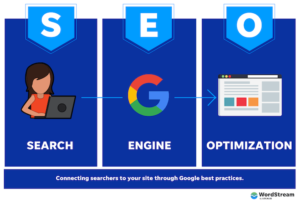Heating, ventilation, and air conditioning systems keep people comfortable in the winter and cool in the summer. They also help filter out odors and other pollutants, maintain air quality, and regulate humidity levels.
Understanding HVAC system working principles can help professional plumber practitioners choose the right type of system and ensure proper installation and maintenance. This will lead to lower energy costs and greater environmental sustainability. Click the https://hubbardmechanical.com/ to learn more.

Heating, ventilation, and air conditioning are important in both homes and businesses. However, many people don’t know that HVAC isn’t just about warming or cooling a space, but rather improving the overall quality of indoor air. This is why the V in HVAC stands for ventilation – it’s not just about air circulation, but also about filtering and regulating temperature.
In modern times, HVAC systems are found in almost all buildings – including residential and commercial buildings, schools, hospitals, offices, and even submarines. They are a key component of environmental comfort and have come a long way since their ancient beginnings. Today, there are a wide variety of different types of HVAC systems, but they all share the same basic function: to warm or cool spaces and improve indoor air quality.
A HVAC system typically works by drawing in fresh outdoor air, circulating it throughout a building, and then expelling stale, warm air. This process removes smoke, odors, heat, dust, and airborne bacteria, as well as controls temperature and humidity. It also helps to oxygenate the air, which is vital for both occupant health and building longevity.
The first HVAC systems were developed in ancient civilizations, where they were used to warm bathhouses and public spaces. During the Industrial Revolution, these systems expanded to include central heating and cooling for factories and large buildings. By the 20th century, electric HVAC systems were commonplace in homes, and the term was shortened to simply HVAC.
To understand how the modern HVAC system works, it’s helpful to take a look at its parts. The most familiar part of an HVAC system is the ductwork, which is responsible for moving air throughout a home or building. The ductwork is connected to the heating and cooling appliances by vents, which are rectangular covers that direct airflow back to the appliance.
The next major part of the HVAC system is the blower, which is responsible for propelling the filtered air through the ductwork and out into the living spaces. This part is driven by an electrical motor, which is powered by electricity or other energy sources like gas. The blower also contains a fan, which is responsible for creating the desired airflow pattern. Finally, the system includes a control panel that allows the user to set and adjust system preferences.
The Evolution of HVAC
Modern heating, ventilation and air conditioning systems have come a long way since their inception. These systems are a vital component of residential structures such as homes and apartment buildings; commercial buildings such as offices and skyscrapers; and transportation vehicles such as cars, trains and planes.
The roots of HVAC stretch back thousands of years, with the ancient Greeks and Romans running channels to distribute heat under marble flooring and the 14th century Europeans using chimneys on their fireplaces and stoves for ventilation. But it wasn’t until the 20th century that HVAC principles really caught on. In 1902, Willis Carrier – who remains synonymous with air conditioning to this day – invented the first contemporary “air conditioner” that used large fans and coils to circulate coolant and control humidity in a printing plant building in Brooklyn, New York.
After that, the development of more efficient refrigerants such as freon and the invention of programmable thermostats allowed for more precise temperature control, which helped drive demand for HVAC systems. This also gave rise to the HVAC industry as we know it today, with a wide range of services and manufacturers.
HVAC systems are complex and incorporate a number of interrelated parts, such as ventilation that brings in outside air, an air handling unit that filters and cleans the air, and ducts to direct the conditioned air to the right spaces. Some systems may also include humidifiers or dehumidifiers that adjust the level of moisture in the air and ozone generators that eliminate odors from cooking, smoking, pet hair and other sources.
A major driver of modern-day HVAC evolution is the growing focus on indoor air quality (IAQ). IAQ affects a person’s health and comfort as well as productivity. Concerns around sick building syndrome, the COVID-19 pandemic and overall workplace wellness have led to a greater focus on HVAC systems that can improve IAQ by regulating temperature, airflow, humidity and even dust and pollen levels.
In addition to the above, the energy crisis of the 1970s and the subsequent environmental awareness saw a focus on improving energy efficiency in HVAC systems. This included the development of reversible air conditioning processes that could import latent outdoor heat energy to create cooling in summer and warmth in winter, and high-efficiency furnaces, air pumps, programmable thermostats and other innovations.
The Future of HVAC
Air conditioning is a big energy consumer, and it’s a significant contributor to greenhouse gas emissions. The HVAC industry will need to continue improving equipment, coolant and maintenance protocols for a sustainable future. For example, new cooling units are increasingly being built with refrigerants that are less harmful to the environment and can be safely reused in the future. These new systems also consume less electricity to run, further reducing energy costs and carbon footprints.
New technologies are making it possible to run heating and cooling systems with renewable energy like solar, wind and geothermal power. This can significantly reduce fossil fuel consumption and reliance. In addition, smart home technology is allowing households to monitor and manage their energy usage in real time. This can be a huge help for families with limited budgets.
Training in modern HVAC technologies and sustainable practices is not just a career choice; it’s becoming an imperative to combat climate change and protect the planet. HVAC professionals who are trained in these areas are better equipped to design and install energy-efficient systems, resulting in substantial cost and energy savings for their clients as well as reduced carbon footprints that align with global environmental goals.
Technology is continuing to improve in all aspects of the HVAC industry. For example, innovative software is aggregating comprehensive HVAC usage data for insights on performance trends and system health. This data can be used to predict issues and plan repairs in advance. Durable nameplates are now being used to make it easier for technicians to identify components, check specifications and source parts for repairs. Some modern software-enabled HVAC systems can even self-diagnose for quicker and more efficient troubleshooting.
The future of the HVAC industry looks bright. The demand for green solutions will only increase in the years to come as consumers continue to make sustainable choices. This will require the support of electric utilities, which must accelerate their shift from coal to renewables. It will also require the industry to spread awareness about electrification and Energy Star-rated HVAC appliances. In addition, innovative systems that use geothermal energy and air to heat and cool will gain popularity among homeowners.
HVAC Facts
HVAC systems regulate and move heated and cooled air throughout buildings, from homes to indoor stadiums. They include heating and cooling units, ventilation systems that direct air into the home or building, humidifiers that adjust the level of humidity, and air cleaners that filter out bacteria, spores, viruses, and other microorganisms. They also include thermostats that control the system to a desired temperature and smart systems that allow you to monitor and change settings remotely.
Despite the complexity and variety of HVAC systems, they all work similarly. They take in air through mechanical ventilation and use a heat exchanger or a refrigerant to heat or cool it. They then distribute the conditioned air through ductwork or, in the case of ductless mini-split systems, directly into the living space. Many systems may include a dehumidifier, which controls the level of moisture in the air, and an air quality sensor that detects and reports on toxins like mold, dust, and pollen.
The HVAC industry is booming, and there are plenty of opportunities to work in the field. Depending on the location, HVAC technicians can find steady work or experience seasonal dips in demand. The states with the highest number of HVAC jobs tend to be those with warm climates, but the consistency of HVAC job availability varies based on other factors as well.
HVAC contractors need to be able to market themselves and attract new clients in order to grow their business. The best way to do this is through online search, and optimizing your website for SEO can help. This will ensure that people who are looking for a local HVAC technician can find your website and contact information. This will boost your profitability and help you to get more business.




